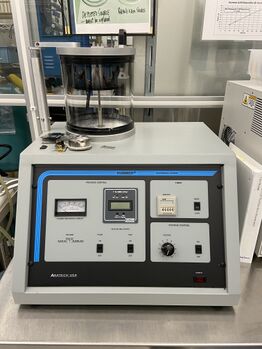SEM Sample Coater (Hummer): Difference between revisions
Jump to navigation
Jump to search
Content deleted Content added
Created page with "{{tool|{{PAGENAME}} |picture=SEMSample.jpg |type = Inspection, Test and Characterization |super= Tony Bosch |location=Bay 1 |description = |manufacturer = Hummer |materials = |…" |
→Operating Procedures: fixed bullet points, listed approx film thickness |
||
| (8 intermediate revisions by 4 users not shown) | |||
| Line 1: | Line 1: | ||
{{ |
{{tool2|{{PAGENAME}} |
||
|picture=SEMSample.jpg |
|picture=SEMSample.jpg |
||
|type = Inspection, Test and Characterization |
|type = Inspection, Test and Characterization |
||
|super= |
|super= Michael Barreraz |
||
|super2= Tony Bosch |
|||
|location=Bay 1 |
|location=Bay 1 |
||
|description = |
|description = |
||
| Line 9: | Line 10: | ||
|toolid= |
|toolid= |
||
}} |
}} |
||
=About= |
|||
This system is for coating thin (1-10nm) AuPd layers onto samples that will reduce charging during FESEM inspection. |
|||
===When to use=== |
|||
If you tried SEM'ing a sample, and the sample appears to drift/move during imaging/capture, or astigmatism is constantly changing, then your sample may be charging up and deflecting the electron beams. This is common for imaging insulators such as substrates made of glass (SiO2), or substrates coated in glass (SiO2, SiN) or thick photoresist (≥1µm). Thin layers (<<1µm) on top of conductive substrates (eg. 200nm SiO2 on Silicon substrate) can often allow electron beams and fields to penetrate to the conductor, possibly not requiring AuPd coating. |
|||
==Operating Procedures== |
|||
* [https://wiki.nanotech.ucsb.edu/w/images/5/5d/SEM_sample_coater_%28hummer%29_instructions.pdf SEM Sample Coater (Hummer) Instructions] |
|||
*[[Hummer SEM Sample Coater - Techniques to reduce charging in SEMs|Techniques to reduce charging in SEMs using Hummer Coater]] |
|||
<br /> |
|||
Latest revision as of 00:17, 2 August 2024
| ||||||||||||||||||||||||
About
This system is for coating thin (1-10nm) AuPd layers onto samples that will reduce charging during FESEM inspection.
When to use
If you tried SEM'ing a sample, and the sample appears to drift/move during imaging/capture, or astigmatism is constantly changing, then your sample may be charging up and deflecting the electron beams. This is common for imaging insulators such as substrates made of glass (SiO2), or substrates coated in glass (SiO2, SiN) or thick photoresist (≥1µm). Thin layers (<<1µm) on top of conductive substrates (eg. 200nm SiO2 on Silicon substrate) can often allow electron beams and fields to penetrate to the conductor, possibly not requiring AuPd coating.
Operating Procedures
